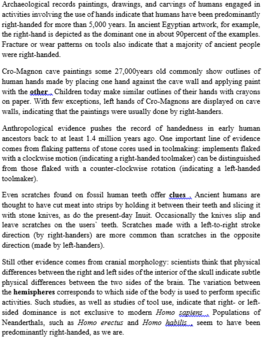Read the following passage and mark the letter A, B, C, or D on your answer sheet to indicate the correct answer to each of the questions from 36 to 43.
Around the year 1500, hunting people occupied the entire northern third of North America. They lived well from the animals with which they shared these lands. Hunters of sea mammals had colonized the Arctic coasts of Canada and Greenland between four and five thousand years before. Land-hunting people had lived throughout much of the northern interior for at least 12,000 years.
Northern North America is part of a larger circumpolar ecological domain that continues across the narrow Bering Strait into Siberia and northern Europe. The overall circumpolar environment in the 1500's was not very different from the environment of the present. This vast landmass had a continental climate and was dominated by cold arctic air throughout a long winter and spring season. Summer temperature ranged from near freezing to the mid-20's Celsius, while winter temperature were often as low as 40 degrees below zero Celsius.
Geographers divide the overall circumpolar domain into two zones, the Arctic and, below it, the Subarctic. They refer to the landforms of these areas as tundra and taiga, respectively.
Temperatures in the northern lands were below freezing for eight or nine months of the year. Subsurface soil in the Arctic's tundra remained permanently frozen. Even when summer temperatures were above freezing and the top inches of earth became saturated with water, the soil below remained frozen into a permafrost, as hard as rock. When water flowed upon the surface of permanently frozen tundra, it made overland travel extremely difficult. Summer travel in the boggy lands, or muskeg country, of the Sub Arctic’s taiga was also slow and arduous. Tracking animals was more difficult than it was during the winter when the swampy ground was frozen solid and covered with snow. In both tundra and taiga, hordes of mosquitoes and biting flies bred in the standing pools of water. Clothing lost its thermal efficiency when it became damp. Northern people looked forward to the turn of the season to bring the easier traveling conditions associated with cold weather. In the Arctic, they could haul food and supplies by dogsled while in the Subarctic; people could travel quickly and efficiently by snowshoes and toboggan.
The subsurface soil in the Arctic's tundra is most comparable to which of the following?
A. Cement
B. A bog
C. A pond
D. Sand






Đáp án A
Thông tin: Subsurface soil in the Arctic's tundra remained permanently frozen.
Dịch nghĩa: Đất dưới bề mặt trong vùng lãnh nguyên Bắc Cực vẫn đóng băng vĩnh viễn.
Như vây nghĩa là vùng đất dưới bề mặt cực kỳ rắn chắc, có thể được so sánh với xi măng. Phương án A. Cement là phương án chính xác nhất.
B. A bog (n) = một cái cầu tiêu.
C. A pond (n) = một cái ao.
D. Sand (n) = cát.